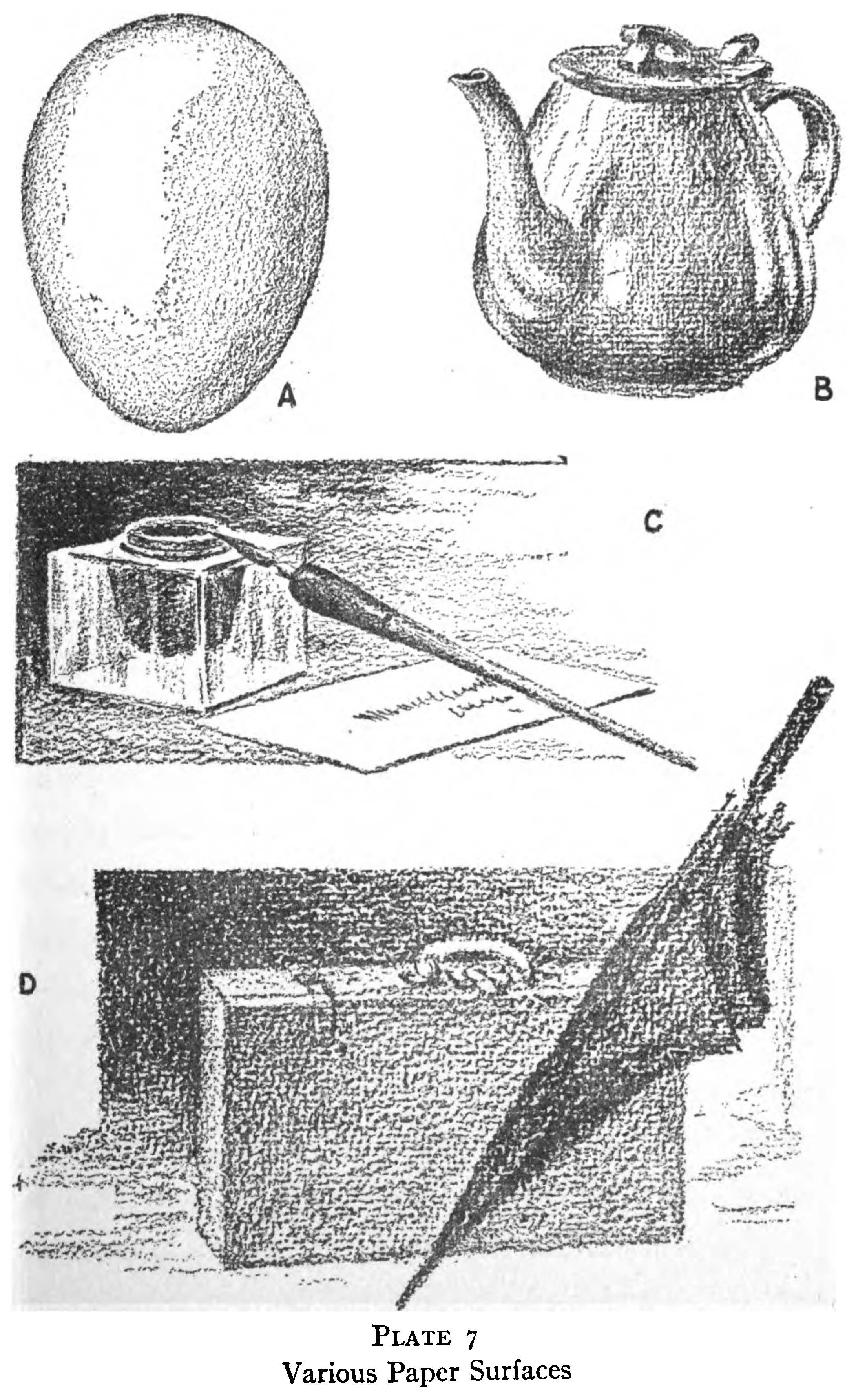Home > Directory of Drawing Lessons > Improving Your Drawings >Shading and Blending> Shading Techniques
Practice Drawing and Shading with Pencil
|
|
Drawing Processes That Will Make You A Better Artist and Drawer
4. Practice Drawing in ShadowPencil to use. The next stage in pencil technique is the introduction of blended shadows, or shading done otherwise than in lines, as in Plates 6 and 7. These should be, at first, of a simple character, such as is shown in Plate 6; mostly massed, and comparatively flat in tone and character, treating principally the basic tones of the objects, with, maybe, the principal shadows on them, or cast by the objects. A softer pencil may be used for this work, HB, or even, if preferred, a crayon or a pencil such as Dixon's 804, which is a kind of mixture between a crayon and ordinary lead. This 804 cannot, however, be used for preliminary work for pen and ink or brush, for the tone is too deep and black, and, because of its greasy character, it is likely also to interfere greatly with the work to be done over it. Value of learning pencil shading. For some kinds of original work, where the drawing is to be of a rather complicated nature, the artist will often make a shaded drawing in pencil and then work over it in pen, brush, or color. By working in this manner, he can locate tones and tints, lights and shadows with his pencil sketch first, and, in case of error or a wish to change, can readily erase, whereas it would be very difficult or impossible to Specimens of work of this kind of shading are shown in Plate 7, though carried somewhat farther than is usually necessary if the drawing is to be worked over in some other medium. These drawings are not intended to be worked over, however, and a knowledge of such pencil technique is absolutely necessary, for there is a constant demand for drawings such as this from customers who wish sketches submitted to them, or who wish to see the drawing before it is inked or washed in. It will be noticed that most of the tones in Plate 6 are flat, with little blending in them. There is a trifle in the background of the basket and a little in the river banks, but the pyramids are made with two tones only. It is well to practice with simple tones at first, gradually progressing to fuller shading. In Plate 7 is also shown one of the studies in Plate carried a little farther; namely, the egg. We have in this plate the outlines of the former one, but with the necessary shading added, to turn that flat geometrical outline into an object with length, breadth, and thickness. In other words, the addition of this shading changes an abstract, geometrical figure into a definite object with shape and depth. Difference in appearance produced by use of different papers. The different effect of the shading in the figures in Plate 7 is obtained by the use of different kinds of papers. For reproductive purposes, it is necessary that the drawing should be made with black pencil (in this case Dixon's 804), but a great change in the appearance can be made by making the drawings on different paper. The tooth on some papers is close and fine, as in the egg, A, which is drawn on a close-grain crayon paper. The teapot, B, is put upon charcoal paper, the inkwell upon a different type of crayon paper, and the umbrella on a rough water-color paper. Because of the loose, coarse texture it would not be possible to make a drawing with any fine detail, such as the inkwell, upon this paper. It is only good for flat, broad effects. A study of the lead pencil is quite necessary to the artist who may wish to do work for reproduction, for it is the basic tool upon which all further technique is founded. It is used to lay out shapes and proportions, and to give a start to all work in pen and ink; wash, or water color, and on it the artist depends for a correct representation of what he is later to finish up in either of these mediums. Because of the facility with which it may be altered, erased, or corrected, he is enabled to get a good and truthful outline of what he wishes upon the paper as a guide for further work, so that when he comes to the use of any of these finishing mediums, he does not have to bother with correcting forms, but simply follows what he has already drawn, in light pencil marks, upon the paper.' His mind is thus left free for the solution of other, and possibly, graver problems, for the pencil drawing has taken care of the original ones of shape, size, position, and proportion. The pencil is in addition very useful for sketching purposes, has a wide range of tone and technique, and has a capacity for quick work that no other medium possesses. Therefore a knowledge of the working of the lead pencil is not only useful but imperative, and time given to acquiring it will be well spent and will bring the artist a more than useful accomplishment. |
Privacy Policy ...... Contact Us










